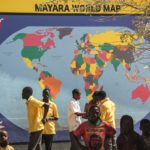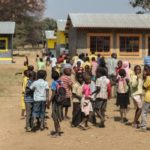Growing up in a small rural community and having both parents involved in our school system has given me a keen interest in education. While preparing for this trip I couldn’t wait to see what 24-year-old Namibia was doing with their public educational system. The facts and figures are not as impressive as one would hope. According to Education for All, which is the government’s plan of action for their public education system, only 838 of Namibia’s 18,117 teachers are actually trained to teach. HIV/AIDS is causing a major teacher shortage and causing many children to become orphans, which leads to them having to drop out to take care of themselves.
But what needs to be understood is that Namibia is trying. They are still a developing country, and while the statistics may not be bright, they have a plan and it is slowly working. The national annual growth rate of attendance in primary school education is 1.8%. In a country where many children are required to assist on their farms daily and nomadic people still live, this is progress.
We went and visited a couple of Aggie Peace Corps volunteers that worked at the Mayara School in northern Namibia. With only a few buildings, they taught grades 1 through 10, and had about 450 students. One of the volunteers, Tim, said that a major problem within the education system is that it’s almost an unwritten rule that if a student fails a grade twice, they are automatically passed on to the next grade. This is causing even more problems, because students can’t be expected to understand higher education when they didn’t even comprehend the grade before. To combat this, Namibia has been trying to better their teacher training and give incentives for teachers to stay in Namibia and not move to other countries.

Tim and Lindsey have been doing their best to brighten up the school and make it a fun learning environment. This map is one of many things they’ve done to encourage learning.
There are many challenges that Namibia has to face. When taking into consideration that they are still a young country, the triumphs are amazing. The Namibian Education System by Friedrich Ebert Stiflung says that the passing rate of 5th grade children has increased from 75% in 1991 to 94% today. Their literacy rate has increased to 93%. Even with daunting challenges, Namibia is making headway to having a successful and prosperous educational system.
